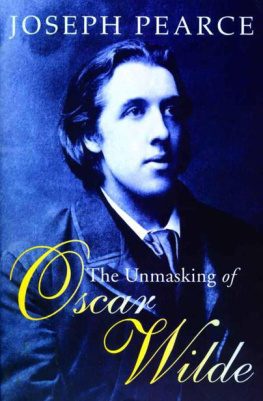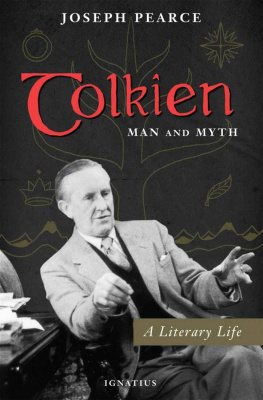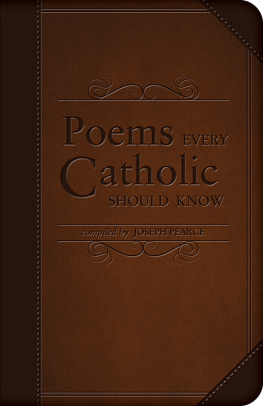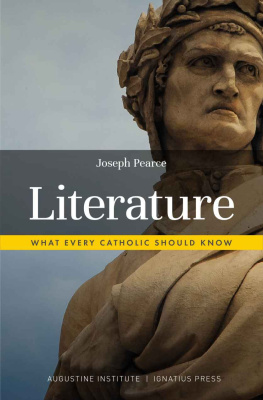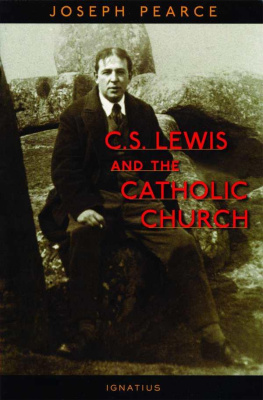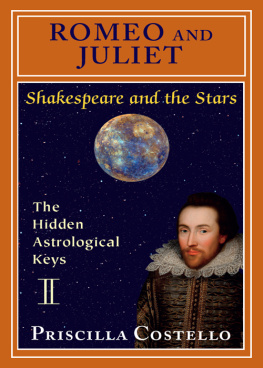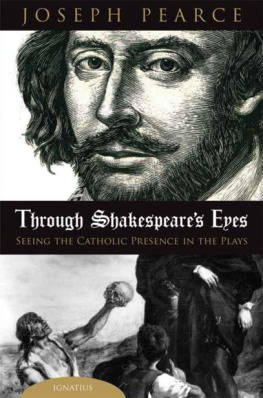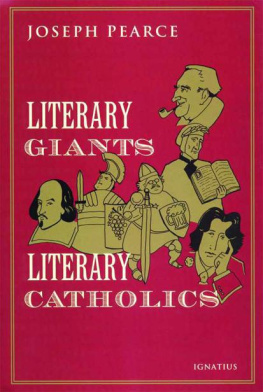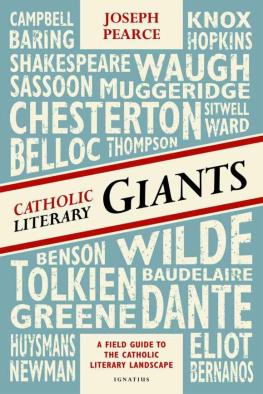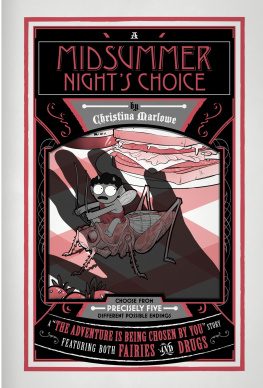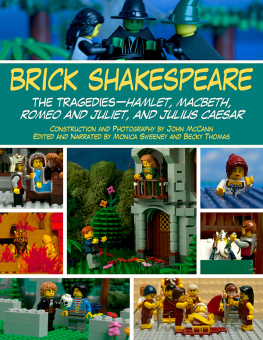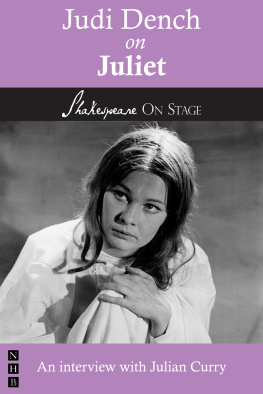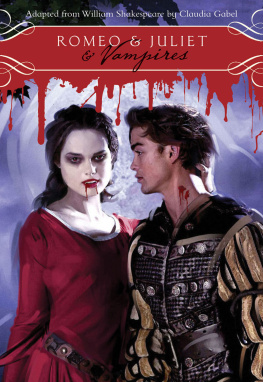SHAKESPEARE ON LOVE
JOSEPH PEARCE
SHAKESPEARE
ON
LOVE
Seeing the Catholic Presence in
Romeo and Juliet
IGNATIUS PRESS SAN FRANCISCO
Cover photo
Juliets Balcony , by Milo Persic
According to local tradition, this house in Verona, Italy,
belonged to the family
that served as Shakespeares inspiration for the Capulets.
Cover design by Milo Persic
2013 by Ignatius Press, San Francisco
All rights reserved
ISBN 978-1-58617-684-6
Library of Congress Control Number 2012942805
Printed in the United States of America
FOR LORNA
WITH
LOVE
CONTENTS
PREFACE
This book rests on the solid conviction that William Shakespeare was a believing Catholic. The evidence for such a conviction has been given in my two previous books The Quest for Shakespeare and Through Shakespeares Eyes . In the first of these volumes the solid documentary and biographical evidence for the Bards Catholicism is given; in the latter the evidence for his Catholicism is gleaned from three of his most celebrated plays, The Merchant of Venice, Hamlet , and King Lear . It should be stated from the outset, therefore, that these other books should be consulted for the definitive proof of Shakespeares Catholic faith, whereas the present volume will simply offer further corroboration of the conclusions reached in the earlier volumes, based on the evidence that emerges in Romeo and Juliet , his most popular play and perhaps the most famous tragedy ever written.
It should also be stressed that the belief in Shakespeares Catholicism is not simply an eccentric and quixotic quest on the part of the present author but is a firmly established field of scholarship. Apart from my own two contributions to the burgeoning library of books on the subject, I will list here some of the most noteworthy.
The Shakespeares and The Old Faith by John Henry De Groot is a meticulously researched study of the Catholicism of Shakespeares family by a Protestant scholar.
The foregoing list is not by any means exhaustive, and those seeking a more thoroughgoing bibliographical grounding in the expansive and expanding body of scholarship in this area should check the bibliography in the aforementioned Quest for Shakespeare . The point, however, is that Shakespeare was a believing Catholic when he wrote his plays, Romeo and Juliet included, and, as such, we should expect to find the presence of the faith, philosophically and theologically, in the midst of this greatest of love stories. Seeing the tragedy unfold through Shakespeares Catholic eyes enables us to see it in a new and surprising light. The following work is an effort to see the play through the eyes of the playwright so that we may be enlightened and surprised by what we see.
ACKNOWLEDGMENTS
For the most part, this book is simply an engagement with the text of Shakespeares most famous play. As such, there are not too many people to acknowledge in the traditional sense in which such people are listed at the beginning of a book. I could and should list those people who have inspired and encouraged me in my love for Shakespeare and the research which is its fruit. Since, however, I listed these people in the acknowledgments of my previous book, Through Shakespeares Eyes , I shall desist from repeating myself on this occasion, which is not to say, of course, that I am any the less indebted to them.
In writing this book, I have gained much from my experience of editing the Ignatius Critical Edition of Romeo and Juliet , published in 2011, and from the insights gleaned from other contributors to that edition, particularly Crystal Downing, Richard Harp, Andrew J. Harvey, Jill Kriegel, Jonathan Marks, Rebecca Munro, and Stephen Zelnick.
It would be remiss of me, and indeed an act of the grossest negligence and ingratitude, were I not to mention those valued benefactors and encouragers of my work at Thomas More College and Ignatius Press who continue to make it possible for me to write and publish my work.
Aptly enough, the final acknowledgment of gratitude belongs to my wife, Susannah. Apart from reading and critiquing every chapter of the present volume as it was written, she has to take on that much greater burden of living with me and my idiosyncrasies. Only through the grace of God can such crosses be borne!
PROLOGUE:
THE GREATEST LOVE STORY EVER TOLD?
In the history of the world, and in the canon of world literature, there have been many great love affairs and many legendary lovers. We think perhaps of Helen and Paris, Odysseus and Penelope, Aeneas and Dido, Antony and Cleopatra, Dante and Beatrice, Paolo and Francesca, Petrarch and Laura. And, of course, whenever we think of the worlds greatest lovers we can scarcely avoid thinking of Romeo and Juliet. Yet when we step back from the list we notice something a little odd about the lovers and their love affairs. We are struck by how different one love affair is from another. On the one hand we have the adulterous passion of Helen and Paris, with its destructive consequences; on the other, we have the loyalty and chastity of the devoted wife Penelope, who serves as a beacon of light on her husbands dark journey home. We have the disastrous love affairs of Aeneas and Dido, and Antony and Cleopatra, in which the lovers are so obsessed with each other that they forget and neglect their duties to their family, friends, and country. We have the adulterous love of Paolo and Francesca that leads to the murder of Francescas husband and the hurtling of the lovers into the hell of their infernal passion. At the other end of the lovers spectrum we have Petrarchs idealized love for the unattainable Laura, and Dantes idealized love for Beatrice, the latter of which, stripped of all selfishness, baptizes Dantes imagination, enabling him to ascend to the mystic heights of beatitude. Thus we see that the right sort of love can lead us to heaven, whereas the wrong sort can condemn us to hell. If this is so, what sort of love do Romeo and Juliet have for each other? Is their love the right sort or the wrong sort? Is it heavenly or hellish? Is it fruitful or destructive?
Romeo and Juliet is perhaps the most famous love story ever written. Its cultural influence is so profound that Shakespeares star crossd lovers have become synonymous with the very meaning of romantic love. But what exactly does the worlds greatest playwright have to say about the worlds greatest lovers? Does he sympathize with their plight? Does he consider them blameless, or are they at least partly responsible for the tragedy that awaits them? Is the love story about fatalistic forces beyond the control of the protagonists, or is it a cautionary tale warning of the dangers of unbridled erotic passion? And what does Shakespeare have to say about the relationship between romantic love, or eros, and the greatest love of all, the love which God has for man, which manifests itself in his giving his only Son as a willing sacrifice for mans salvation? What relationship is there between eros and caritas, between the romantic love between a man and a woman and the love of Christ for humanity? What is the connection between the most famous love story ever written and the Greatest Love that there is? These questions are asked and answered in the following pages as we endeavor to see Romeo and Juliet through Shakespeares devoutly Catholic eyes.
1
CREATIVE REVISION AND
CRITICAL MISREADING
As with so many of Shakespeares plays, the exact date of Romeo and Juliets composition is shrouded in mystery and is the cause of much scholarly argument and disagreement. When it appeared in print for the first time, in 1597, the title page referred to its being performed with great applause by Lord Hunsdons Men. Since Shakespeares acting troupe was known as Lord Hunsdons Men only between July 1596 and March 1597 it is assumed, logically enough, that the play must have been written in 1595 or 1596. Some scholars believe, however, that it was written as early as 1591, arguing that the Nurses remark Tis since the earthquake now eleven years (1.3.24) constitutes a clear allusion to the London earthquake of 1580. Countering such a suggestion, advocates of the later date refer to William Covells Polimanteia , a work with which they presume Shakespeare was aware, that alludes to an earthquake of 1584.
Next page


